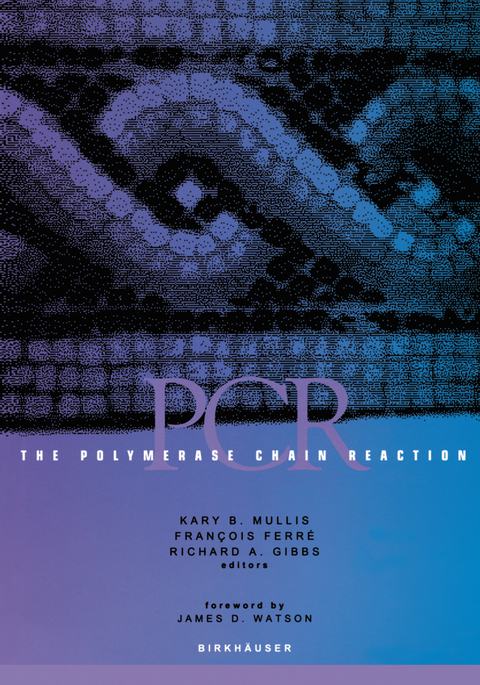
The Polymerase Chain Reaction
Birkhauser Boston Inc (Verlag)
978-0-8176-3750-7 (ISBN)
James D. Watson When, in late March of 1953, Francis Crick and I came to write the first Nature paper describing the double helical structure of the DNA molecule, Francis had wanted to include a lengthy discussion of the genetic implications of a molecule whose struc ture we had divined from a minimum of experimental data and on theoretical argu ments based on physical principles. But I felt that this might be tempting fate, given that we had not yet seen the detailed evidence from King's College. Nevertheless, we reached a compromise and decided to include a sentence that pointed to the biological significance of the molecule's key feature-the complementary pairing of the bases. "It has not escaped our notice," Francis wrote, "that the specific pairing that we have postulated immediately suggests a possible copying mechanism for the genetic material." By May, when we were writing the second Nature paper, I was more confident that the proposed structure was at the very least substantially correct, so that this second paper contains a discussion of molecular self-duplication using templates or molds. We pointed out that, as a consequence of base pairing, a DNA molecule has two chains that are complementary to each other. Each chain could then act ". . . as a template for the formation on itself of a new companion chain, so that eventually we shall have two pairs of chains, where we only had one before" and, moreover, " ...
One: Methodology.- I. Basic Methodology.- 1. Manipulation of DNA by PCR.- 2. Cloning PCR Products.- 3. Optimization of Multiplex PCRs.- 4. Preparation of Nucleic Acids for Archival Material.- 5. PCR Amplification of Viral DNA and Viral Host Cell mRNAs in Situ.- II. Quantitation.- 6. Quantitative PCR: An Overview.- 7. Quantification of DNAs by the Polymerase Chain Reaction Using an Internal Control.- 8. RT-PCR and mRNA Quantitation.- 9. Analysis of Human T-Cell Repertoires by PCR.- III. Nonisotopic Detection.- 10. Ultrasensitive Nonradioactive Detection of PCR Reactions: An Overview.- 11. Fluorescent Detection Methods for PCR Analysis.- 12. Enzyme-Labeled Oligonucleotides.- 13. Application of the Hybridization Protection Assay (HPA) to PCR.- IV. Instrumentation.- 14. PCR Instrumentation: Where Do We Stand?.- 15. Rapid Cycle DNA Amplification.- 16. Automating the PCR Process.- V. Sequencing.- 17. PCR and DNA Sequencing.- 18. Phage Promoter-Based Methods for Sequencing and Screening for Mutations.- 19. Capture PCR: An Efficient Method for Walking Along Chromosomal DNA and cDNA.- Two: Applications.- I. General Applications.- 20. In Vitro Evolution of Functional Nucleic Acids: High-Affinity RNA Ligands of the HIV-1 rev Protein.- 21. The Application of PCR to Forensic Science.- 22. Recreating the Past by PCR.- 23. Nonbiological Applications.- II. Genetic Analysis.- 24. RT-PCR and Gene Expression.- 25. Fingerprinting Using Arbitrarily Primed PCR: Application to Genetic Mapping, Population Biology, Epidemiology, and Detection of Differentially Expressed RNAs.- 26. Genetics, Plants, and the Polymerase Chain Reaction.- III. Assessment of Therapy Effectiveness.- 27. PCR Assessment of the Efficacy of Therapy in Philadelphia Chromosome-Positive Leukemias.- 28. The Detection of Minimal Residual Disease (MRD) in Acute Lymphoblastic Leukemia Using Clone-Specific Probes Directed against V(D)J Junctional Sequences.- 29. Assessment of Therapy Effectiveness: Infectious Disease.- 30. Gene Therapy.- IV. Diagnostics.- 31. PCR and Cancer Diagnostics: Detection and Characterization of Single Point Mutations in Oncogenes and Antioncogenes.- 32. Clinical Applications of the Polymerase Chain Reaction.- 33. Infectious Diseases.- Three: PCR and the World of Business.- 34. PCR in the Marketplace.- 35. PCR and Scientific Invention: The Trial of DuPont vs. Cetus.
| Reihe/Serie | The Polymerase Chain Reaction | 1.10 |
|---|---|
| Vorwort | J.D. Watson |
| Zusatzinfo | 85 Illustrations, black and white; XXII, 458 p. 85 illus. |
| Verlagsort | Secaucus |
| Sprache | englisch |
| Maße | 178 x 254 mm |
| Themenwelt | Medizin / Pharmazie ► Pharmazie ► PTA / PKA |
| Naturwissenschaften ► Biologie ► Genetik / Molekularbiologie | |
| Technik ► Umwelttechnik / Biotechnologie | |
| ISBN-10 | 0-8176-3750-8 / 0817637508 |
| ISBN-13 | 978-0-8176-3750-7 / 9780817637507 |
| Zustand | Neuware |
| Informationen gemäß Produktsicherheitsverordnung (GPSR) | |
| Haben Sie eine Frage zum Produkt? |
aus dem Bereich


